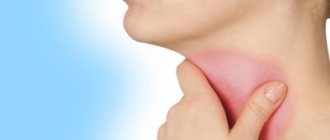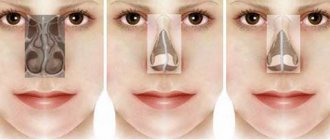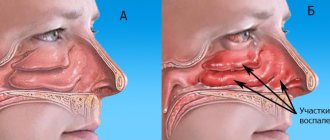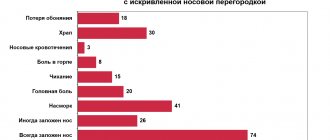Pain is a symbol of trouble with which our body responds to emerging problems. Only when we feel pain do we understand that something is wrong with our body, and we consult a doctor, take medications, in a word, we try to eliminate the cause of the problem.
If your nose reacts with pain, this situation should be especially worrying, since any disease of the nose can affect your appearance, and serious problems can cause damage to the entire body as a whole. The brain is at particular risk - close proximity in the event of a dangerous injury or infection threatens its damage. Such problems are difficult to treat and sometimes even lead to death. So if the inside of your nose hurts, don’t hesitate, go to the doctor.
Causes of nasal pain
The most common cause of pain inside the nose is inflammation of its mucous membrane.
There can be many reasons why the inside of the nose hurts, and all of them are associated with various effects on this area of the face. Conventionally, they can be divided into several groups:
- Caused by external reasons.
- Triggered by internal diseases.
- Resulting from injuries.
Among the external causes that can provoke pain inside the nose, the most common are abscesses or boils. Since the skin on the nose is rich in sebaceous glands, and the pores are quite wide, wider than on other parts of the body, infection can easily get into them, causing a severe inflammatory process. Deep abscesses can be very painful, and the unpleasant sensations “radiate” deep into the nose. It is very important to never squeeze any type of abscess on the nose, especially those located at the base of the nose or on the inside of the nostrils. Fine hairs grow in these places in the nose. An infection that has entered the hair follicle can cause severe inflammation and the formation of very painful suppuration. It must be treated, but not squeezed out, otherwise you can simply spread the infection and aggravate the situation to dangerous limits.
External causes that cause pain in the nose can be considered a variety of allergens that provoke allergic rhinitis, air contaminated with dust, toxic chemicals and biological substances, exposure to a very hot and dry atmosphere, a variety of pungent and aggressive aromas, especially aerosols. They can cause severe burns to the nasal mucosa, leading to inflammation and pain. In domestic conditions, the most common cause of chemical burns and severe nasal pain are chlorine-based cleaning products.
Internal causes that cause pain in the nose include various colds - rhinitis, sinusitis, sinusitis and many others.
All of them cause swelling and inflammation of the nasal mucosa, severe soreness and crusting in the nose. The most dangerous causes of pain inside the nose are atrophic rhinitis and its complicated form - ozena. Both diseases are characterized by changes in the condition of the mucous membrane, its atrophy, dryness and crusting, the appearance of a terrible odor, bleeding, and subsequently loss of smell.
More information about nasal diseases can be found in the video:
Pain and discomfort in the nose can be caused by a foreign body lodged in it. Most often this happens to small children who push berries, beads, coins, even small figures into their nasal passages. Getting stuck deep in the nose, such objects put pressure on the nerve endings, causing pain; the body responds with swelling of the mucous membrane, which further increases pain and discomfort.
Injuries can damage the bone and cartilage tissue of the nose. In severe cases, the usual indicator is the presence of bleeding and very severe pain, especially if the nose is broken. But in some cases, when there is only a crack or fracture of the nasal septum, a severe bruise of the cartilage, the victim may only feel pain inside the nose, then swelling and inflammation develop. The condition can be dangerous and requires seeking medical help.
Danger signs
If pain inside the nose is accompanied by alarming symptoms, you need to consult a doctor for examination.
Alarming signs are increasing pain, swelling spreading across the face, the appearance of blue circles and swelling under the eyes, fever, chills, nasal discharge or nosebleeds, changes in the sense of smell - absence or distortion of odors, vision problems (conjunctivitis, pain in the eyes, double vision and so on), headache, weakness.
All of these symptoms together and each individually may indicate the presence of a life-threatening infectious process or be the consequences of injury. In such cases, immediate consultation with a doctor is required, and if the situation rapidly worsens, call an ambulance.
Such signs are especially dangerous in children. They can mean anything - from a toy stuffed deep into the nose to a dangerous injury, a severe infection that threatens meningitis, so it is important for parents to understand that delay in such a situation is unacceptable. It is better to go to the doctor and make sure that everything is fine with the child than to then go to the hospital and treat the consequences of your oversight.
Symptoms of swelling in the nose
How does swelling of the nasal mucosa manifest without a runny nose? A person faced with such a problem cannot breathe normally. He loses his sense of smell and is unable to sense even strong odors. With severe swelling of the mucous membrane, the patient has to breathe through the mouth. All this is not only unpleasant, but also quite dangerous.
If you remain in this state for a long time, the nasal mucous membranes dry out, become inflamed, and cracks and erosions appear on them. Treating this problem is already more difficult than banal congestion. Therefore, if you experience nasal swelling (without a runny nose), the reasons need to be determined as soon as possible. A specialist can do this correctly.
Types and use of medications
Treatment for pain inside the nose depends on the cause of its occurrence.
To find out why the inside of your nose hurts, you need to go to the doctor and make the correct diagnosis, and then get recommendations for treatment. Since there are many causes of nasal pain, each of them requires its own approach.
For inflammation caused by a bacterial infection, a variety of antibiotics are used; if it is of a viral origin, antiviral agents are used; if the cause of the pain is a fungus, then antifungal agents are used. But usually treatment is not limited to one drug, but is carried out in combination.
The patient is prescribed specific profile drugs (for example, antibiotics), anti-inflammatory drugs, painkillers, antihistamines, and, if necessary, vasoconstrictors if there is a severe runny nose and swelling of the mucous membrane. If nosebleeds are severe, your doctor may decide to use anticoagulants.
Since all medications have their own areas of application, specific dosages, indications and contraindications, it is unacceptable to use them at your own discretion.
This primarily concerns antibiotics. It's time to understand that these drugs are not a panacea for all diseases, and in some situations they can themselves cause the appearance of various diseases. Since there are many causes of nasal pain, and only a doctor can make an accurate diagnosis based on the results of tests and examinations, the choice of drugs for treatment depends on the type of disease. Therefore, do not experiment with your health, go to the hospital and follow the instructions of a specialist.
Folk recipes
Washing the nasal passages is an effective method for treating nasal diseases.
Traditional medicine is characterized by the use of a variety of washes, drops and ointments:
- If there are painful crusts in the nose, the mucous membrane is inflamed and swollen, the nose is clogged, and the sinuses are swollen, traditional healers suggest using a simple and accessible procedure - rinsing the nose with salt water. This method of treatment has several types of effects at once: it removes accumulated mucus and crusts, due to the content of sea salt, it reduces swelling and has an anti-inflammatory and disinfectant effect.
- Instilling plant juices, such as aloe, can quickly relieve inflammation, reduce swelling and eliminate pain. Such folk remedies accelerate the regeneration of the mucous membrane.
- Oil-based ointments and drops coat dry and irritated mucous membranes, reducing contact with air. This immediately removes pain, makes the mucous membranes softer, softens and removes crusts. This approach contributes to the rapid disappearance of pain.
It must be remembered that such methods only cope with internal and external reasons why the nose hurts inside.
Surgery
Surgical intervention is indispensable in case of various types of serious injuries, foreign body entry, or damage to the integrity of the nasal bones and/or cartilage. A surgical procedure will also have to be performed in case of complicated sinusitis that does not respond to conservative drug treatment.
If we are talking about a foreign body, most often it is simply carefully removed; surgical intervention has to be resorted to in rare cases. If the object has damaged the mucous membranes, it is necessary to treat them against infection and prescribe special medications.
If the reason why the inside of the nose hurts is an injury, you cannot do without surgery. A special splint is placed on the broken nose to restore the normal position of the cartilage and help restore its correct shape. Crushing or breaking off parts of the nasal septum, damage to the bridge of the nose will require the delicate work of maxillofacial and plastic surgeons.
The cause of severe pain in the nose can be prolonged or chronic sinusitis; if it cannot be treated with medications and physical therapy, surgery must be resorted to.
A puncture turns out to be much less evil than a constant source of infection in the body in close proximity to the brain. Modern techniques make it possible to perform it using the most gentle methods, after which the patient can finally get rid of the pain in the nose that has been tormenting him.
Nasal pain is not as safe as it seems at first glance. At the slightest suspicion of trouble, consult a doctor, and you can avoid many problems and troubles.
Many people are familiar with the feeling when the inside of the nose hurts. In most cases, this unpleasant sensation occurs with rhinitis. But not only this cold symptom is the cause of pain. In reality there are a large number of them.
If the inside of the nose hurts when pressed, this indicates that some kind of inflammatory process is occurring, since almost all the nerve endings of the organ are concentrated in its internal part. And various kinds of provocateurs have an inflammatory effect on the nasal mucosa, which, in turn, is accompanied by the occurrence of pain. Sometimes the patient cannot confidently determine the place where the disease develops.
There may be several internal causes of pain in the nasal cartilage area:
Nose injuries
– bruise, violation of the integrity of the mucous membrane. In this case, the pain is acute and occurs immediately after a blow, fall and other similar situations;
– gives pain of great intensity, caused by the accumulation of contents in the maxillary sinus, when released, the pain subsides. The pain radiates to the forehead and teeth, intensifies at night and in the morning. May be accompanied by symptoms of a cold - high fever, chills, nasal congestion, runny nose. Signs of chronicity of the process are pain - tolerable, pressing, combined with headaches and malaise. Increased pain is provoked by fatigue, overheating, and physical activity;
In this case, the pain is caused by inflammation of the nasal mucosa and is of an unexpressed nature. More striking manifestations of the disease are nasal discharge, congestion, headaches, and there may be a high temperature. In the case of rhinitis of an allergic nature, the pain is also mild and occurs against the background of burning, itching, and nasal congestion. In addition, inhalation of an allergen (animal fur, dust, plant or flower pollen, etc.) leads to profuse nasal discharge, eyes watery and red;
Tumors
– some nasal tumors give an unexpressed pain syndrome, and are often accompanied by difficulty breathing, purulent discharge and spontaneous discharge. A growing tumor can also cause a deformed nose;
Charlin's syndrome
(nasociliary nerve) – you can think about this disease if your nose hurts more often at night, and the pain is paroxysmal in nature. Attacks can last from 10 minutes to several days. The pain during an attack is pressing, bursting, one-sided, and can radiate to the eye and forehead;
Inflammation of the pterygopalatine ganglion (ganglionitis)
– this disease is manifested by sharp, spontaneously occurring pain in the nose, eye area, and upper jaw. They can spread further - to the temples, back of the head, neck and shoulders.
Causes
If the slightest sign of discomfort occurs, you should not make a diagnosis yourself, because this should only be done by a specialist. When the inside of the nose hurts, the doctor will prescribe what to treat after carefully examining the patient and determining the real cause of the pain.
The causes of these unpleasant sensations can be the following diseases:
- rhinitis;
- allergic rhinitis;
- hypertrophic rhinitis;
- sinusitis;
- chronic sinusitis.
Rhinitis
With rhinitis, the process of inflammation provokes swelling of the nasal mucosa, due to which there is a constant secretion of mucus from it. There are two types of this disease:
- spicy;
- chronic.
The secreted mucus causes constant discomfort. For this reason, it is worth treating something like a not very serious cold symptom responsibly, and not hoping that it will go away on its own.
With allergic rhinitis, the inside of the nasal mucosa hurts, as constantly secreted mucus and sneezing irritate it. The worst thing is when the allergen is present regularly and it is extremely difficult to avoid. For example, at work.
Sinusitis
If chronic sinusitis is observed, then the inside of the nose hurts when the disease worsens or during enormous physical exertion that provokes overwork. In addition, the following symptoms are also observed:
- general weakness or malaise;
- body temperature rises slightly.
In this case, you need to urgently contact a specialist to prescribe adequate treatment, which should be based on antibiotic therapy. Each of these diseases requires special treatment, which is aimed at preventing all sorts of complications from arising.
Other reasons
Why does the inside of the nose hurt, especially if you press a little? Considering this topic, we can identify several diseases that provoke this symptom:
- One of the main ones is sinusitis. Since it can be unilateral or bilateral, during inflammatory processes pain when pressed occurs on both one side and the other.
- The next most painful problem is herpes. Perhaps not everyone knows that this type of disease manifests itself not only on the lips, but also in the nasal cavity. Most often it can be observed at the tip of the organ, less often on the wing.
- A boil that resembles an abscess, but is accompanied by pain.
- An injury can cause pain even at the slightest touch.
If the inside of the tip of the nose hurts, this indicates that some kind of disease is affecting the internal epithelium of the nasal cavity. This can happen for various reasons. These include:
- herpes, when not only the external side of the organ is affected, but also the internal one;
- a disease with the manifestation of acne, which can occur on the nasal wings;
- furunculosis, characterized by increased redness;
- for burns or frostbite.
If pain occurs in this area of the nose, a visit to a specialist cannot be postponed for a long period. Since this will help to avoid many diseases associated with disruption of the immune system.
What contributes to the formation of nasal swelling without a runny nose?
Nasal swelling is a common problem among residents of big cities. Poor ecology, which is constantly getting worse, has a negative impact on the human body. The structure of the nasopharynx involves ensuring the protection of organs from harmful factors. The epithelium of its mucous membrane has many small cilia that prevent the entry of dust and other harmful substances from the surrounding air. But sometimes a malfunction occurs, and the nasopharyngeal mucosa swells greatly, causing congestion.
Discomfort without a runny nose can be caused by exposure to various allergens, for example, chemical irritants, plant pollen, and fluff from flowering poplars. Swelling of an allergic nature can be recognized by auxiliary symptoms: burning, active sneezing, itching, lacrimation, swelling of the face.
Swelling of the mucous membrane is often a consequence of excessive use of vasoconstrictors. If the patient does not comply with the timing and dosage, the medication stops helping and leads to tissue swelling. Also, the situation may worsen immediately after stopping the medication due to the tendency to get used to its active ingredients.
When the nasal sinuses become inflamed as a result of exposure to viruses or bacteria, a severe runny nose with swelling immediately occurs. Sinusitis and sinusitis are successfully treated, but they often leave behind unpleasant nasal congestion. In these cases, a severe runny nose and then swelling are immediately eliminated.
The tissues of the nose may become enlarged due to inflammation in the tooth root of the upper jaw.
The occurrence of edema is often provoked by viral diseases, injuries, atrophic processes in the nose, and deviated septum. Inflammation of polyps, adenoids, and the appearance of neoplasms can also cause nasal congestion. The entry of a foreign particle into the nasal cavity is also accompanied by congestion. In pregnant women, the problem occurs due to changes in hormonal levels. Congestion is a common symptom of alcoholism, drug addiction, or a reaction to certain medications.
Streptoderma
In some cases, a slightly different picture of the course of diseases affecting the organ is observed. When the inside of the nose hurts, the resulting sores bring a lot of discomfort. This disease is called streptoderma. This phenomenon occurs as follows. Initially, redness appears on the skin. After this, a bubble filled with liquid appears. When it bursts, the mucous membrane remains exposed. Now it is an excellent window into the body for various infections.
This area dries out quite quickly, but is accompanied by increased itching, which provokes scratching of the damaged area, especially in this case, children cannot restrain themselves. Then the infection, under the influence of the ongoing disease, can spread throughout the body. This disease can be transmitted through contact with a sick person. So, at the first signs, you should contact a specialist in order to protect not only yourself from complications, but also those around you from infection.
Inflammation of blood vessels or poor lifestyle
Sometimes, when the inside of the nose hurts, it can be caused by inflammatory processes in the blood vessels. This happens due to the fact that a person leads an incorrect lifestyle, eats foods that have a bad effect on the body, and also due to the abuse of bad habits.
Pain in the nasal cavity when pressed can be caused by improper use of pharmaceutical drugs, which in most cases people use to treat, for example, rhinitis, on their own. Using them for a long time, they do not take into account the fact that it is absolutely impossible to do this. As a result, the nasal mucosa either grows or dries out. And this will already lead to complications in the form of atrophic or hypertrophic rhinitis.
Nasal swelling during pregnancy
Expectant mothers also often experience nasal congestion. This happens at different times. It has been clinically confirmed that every second woman experiences nasal swelling during pregnancy. It is caused by hormonal changes. During this period, progesterone predominates in the body. It has a relaxing effect on muscle tissue. The nasal mucosa is also subject to the same effect. The vessels dilate. The situation is aggravated by the fact that the volume of circulating blood in expectant mothers increases.
There are no specific drugs to correct this condition. Expectant mothers are not at all recommended to use medications. Therefore, experts allow the use of only saline solutions. They relieve swelling due to their composition. Salt attracts excess fluid, reducing its content in the nasal mucosa. If the congestion is so severe that the expectant mother is forced to breathe through her mouth, then the doctor may prescribe vasoconstrictor medications. It is unacceptable to use them yourself.
Neuralgia
But there are also cases when the inside of the nose hurts, and the reason for this manifestation is unclear. Apart from discomfort, no other symptoms are observed. In this case, pain occurs not only in the nose, but also radiates to the eyes, ears, forehead, and teeth.
Such sensations are considered symptoms of neurological diseases. This mainly refers to inflammatory processes that spread to the nerves. With neuralgia, pain appears depending on which nerve is damaged.
In this case, treatment should be carried out under the supervision of a specialist. The neurologist will first eliminate the source of the disease using medications or physical therapy. If such manipulations do not give a positive result, then surgical intervention is resorted to.
Treatment in adults
Swelling of the nose without a runny nose can be treated with several methods:
medication; folk remedies; physiotherapy.
Before starting treatment, it is important to determine the cause of the problem. It's easy to do it yourself. Often it is enough to ensure a normal level of humidity and temperature in a person’s habitat, and congestion will go away on its own.
If the pathology is allergic in nature, you must first get rid of the allergen.
In other cases, qualified treatment with medications is required; in especially severe cases, surgery may be necessary. Therefore, if you were unable to determine the source that caused the swelling on your own, you should consult a doctor for advice. The doctor will make a diagnosis and select adequate ways to eliminate the problem, which will reduce the risk of complications.
If there is a deviated septum, surgery is definitely prescribed. The process of correcting the pathology is based on the removal of overgrown cartilage tissue. The duration of the procedure depends on the severity and type of deformity. Sometimes swelling of the gland is caused by the formation of cysts and pseudocysts that deform the nasopharyngeal bone. In this case, therapeutic and surgical methods are used, depending on the causes and complexity of the pathology.
Inflammation in the maxillary sinus - sinusitis and sinusitis that last more than a month are considered protracted, and after 1.5 months the acute forms become chronic. In each individual case, individual treatment is selected. A puncture is often prescribed. Immediately wash with saline solution, then administer an antibiotic. In some cases, surgery is prescribed: intranasal or extranasal under general anesthesia. At home, with chronic swelling of the nose, the condition is alleviated by methods aimed at improving blood flow and strengthening the vessels of the mucous membrane:
Paring the legs and using mustard plasters applied to the calves. You can increase the effect with a hot raspberry drink or with honey, linden tea. Massage the T-shaped facial area with your fingertips. To improve the effect, essential oils of eucalyptus, fir, and pine are used. Rinsing with saline solution, sea water, salt-soda liquid. Sand and salt warming. To do this, a fabric bag is filled with bulk material, which is heated and applied to the bridge of the nose.
Consult a doctor
If the slightest signs of pain occur in the nose, then you should not leave it to chance, just as you should not do anything on your own.
This will protect not only from complications, but also from the occurrence of other pathologies. It is worth noting that without prior consultation with a specialist, you cannot use traditional medicine recipes. This can not only cause an allergic reaction, but also further affect the patient’s well-being.
Pain in the cartilaginous part of the nose: what to do?
The only reason from the above for which most of us already know what to do if the nasal cartilage hurts against the background of discharge from it is rhinitis. In this case, we have a variety of ready-made medications and traditional medicine recipes at our service. Although an examination by a general practitioner will also not be superfluous. In all other cases, contacting a medical specialist (surgeon, neurologist or allergist) is mandatory.
The cause of pain in the nose, pain in the nasal cartilage is primarily mechanical damage to the nose. Absolutely all unpleasant sensations of a painful nature arise due to injuries to the nasal septum, as well as as a result of chronic diseases.
Mechanical injury to the nasal cartilage is characterized by displacement of the osteochondral plate. And this is what leads to the fact that a person periodically experiences painful sensations. The cartilage of the nose begins to hurt when the osteochondral plate is divided into two parts.
The cartilage of the nose hurts immediately at the time of injury to the nose, as a result of a fracture, after bruises. In addition to unpleasant sensations, a person may spontaneously bleed, experience difficulties with respiratory function, swelling, and pain.
If the mechanical injury was severe, then the occurrence of a deviated septum, the formation of suppuration, bruising, and tissue damage is not denied. If such injuries occur, then it is necessary to contact a traumatologist or surgeon to provide professional medical care. Otherwise, there is a risk of complications. As a rule, after injuries (bruises, fractures), an inflammatory process begins in a person.
A deviated nasal septum is a fertile ground for the formation of an abscess.
Diagnosis
Why pain occurs inside the nasal cavity must be determined by an otolaryngologist, of course, if this is not a consequence of injury, when you need to contact a surgeon. To make a diagnosis, the specialist is primarily interested in the general condition of the patient and what changes he feels in his body. After this, using a rhinoscope, he examines both the outer and inner parts of the nose.
For a more accurate diagnosis, the doctor may also prescribe additional tests:
For more suspicious symptoms, a biopsy or bacteriological analysis of mucus may be performed to clarify the diagnosis.
Every person has experienced nasal pain. A common cause of this symptom can be ordinary rhinitis, however, there are actually a lot of reasons. There are few nerve endings on the outer surface, but on the inside there are many of them on the mucous membrane. Therefore, it mainly hurts a person if the mucous membrane becomes inflamed. If even minor pain occurs, you need to consult an ENT doctor; advanced disease entails serious consequences.
What to do
Due to the wide variety of reasons that cause swelling and soreness of the nose on one or both sides, in every unclear case you should consult a doctor. The otorhinolaryngologist conducts a visual examination, after which he can make a diagnosis. In unclear cases, CT (computed tomography), MRI or radiography comes to the rescue. In case of head and face injuries, you should immediately consult a surgeon. Suspicion of a boil is also a direct indication for contacting a medical institution.
In no case should you self-medicate, pick or squeeze out the contents of the abscess; a boil is dangerous due to the development of an abscess and thrombosis of the cavernous sinuses of the brain.
You can only treat colds on your own if the disease is mild. Painful inflammatory infiltrates on the outside of the nose can be lubricated with vodka or an alcohol solution of calendula. Antibiotics or other systemic drugs should only be taken as prescribed by a doctor.
From the video you will learn that nasal breathing exercises according to Ibragimov help with a swollen nose:
Reasons why the inside of the nose hurts
There are a number of reasons why the patient feels pain inside the nasal cavity:
- sinusitis. With an inflammatory process in the maxillary sinus, the patient feels pain or discomfort in the sinuses. This occurs due to the fact that the mucous membrane swells and the outflow of mucus becomes difficult. Pain symptoms are possible only on one or both sides. When you press on the area of inflammation, the pain intensifies. Pathological manifestations are more pronounced in the morning;
- for chronic sinusitis. In this case, it only becomes painful when you are overworked, physically stressed, or have an exacerbation of the disease. This manifestation is accompanied by general malaise and a slight increase in temperature. To alleviate the condition, comprehensive adequate treatment must be prescribed. In some cases, a course of antibiotic therapy is prescribed;
- Rhinitis (runny nose) is an inflammatory process, the mucous membrane swells and mucus is constantly released. There is an acute or chronic form. The secreted mucus causes constant discomfort to a person, so it is worth taking a comprehensive approach to treatment. Although there is an assumption that rhinitis can be cured on its own;
- allergies or allergic rhinitis. With this disease, a person suffers from sneezing and constant mucus production. Allergy manifestations become more pronounced upon contact with an allergen;
- hypertrophic rhinitis is a change in tissue in the nasal cavity. Why does it appear? Cancer, polluted air, frequent climate changes, adenoids are the main causes of the disease. With this type of rhinitis, the tip of the nose often cracks and this causes severe pain to the person;
For each disease, comprehensive treatment must be prescribed to prevent complications.
The mechanism of the appearance of swelling of the bridge of the nose
Edema is usually called the accumulation of fluid in soft tissues. This occurs when blood vessels are damaged or inflamed, which increases vascular permeability.
Only specialists can determine the mechanism of swelling of the bridge of the nose and the causes of the problem. In order to understand why the bridge of the nose swells and edema develops, it is necessary to take into account many different factors: from local pathology to disorders of internal organs and systems. Establishing the cause of swelling of the forehead of the bridge of the nose allows you to choose effective treatment.
Edema is the accumulation of fluid in soft tissues, most often the subcutaneous tissue. This occurs due to increased vascular permeability, inflammatory changes or damage. And to understand what mechanisms and factors underlie this condition, you should consult a doctor. Only a specialist can adequately assess the likelihood of a particular cause. And they are different:
- Rhinosinusitis.
- Allergic reactions.
- Injuries.
- Kidney problems.
In addition, swelling of the bridge of the nose occurs after surgical interventions in the area of the external nose, forehead and orbit. In women, a similar reaction is possible when applying permanent eyebrow makeup (tattooing) or as a result of mesotherapy. It is also necessary to take into account the work of the endocrine and cardiovascular systems, because they have a direct impact on fluid exchange in tissues.
Why does your nose hurt when you press it?
It hurts the patient when pressed. In this case, there are some diseases in which such a symptom occurs:
- sinusitis. With this disease, the pain intensifies with pressure from the inflammatory process. The inflammatory process can be unilateral or bilateral;
- herpes. It occurs not only on the lips, but also in the nasal cavity. When touched, pain is felt. It is most often localized at the tip and affects the wing of the nose;
- furuncle;
- injury.
You should seek advice immediately.
The tip of the nose hurts. Reasons for this symptom
The tip is covered with skin on the outside and epithelium on the inside. If it is swollen or red, this indicates the following diseases:
- if the nose and its tip are swollen, this may mean an injury or fracture, while the nose hurts greatly and the color of the skin may change. Symptoms last a long time;
- herpes, affects the mucous membrane and skin;
- acne also spreads to the wings of the nose;
- furunculosis, severe redness;
- burn or, conversely, frostbite.
To prevent a number of diseases, it is necessary to boost the immune system.
My nose is swollen on only one side
There are cases when swelling or swelling appears on only one side. In this case, pain may appear when blowing your nose, the color of the swollen area may change, and you may feel dry. This condition can occur in certain pathological processes:
- barley. If the stye affects the eyes, the swelling may spread to one side of the sinus;
- boil inside the sinus cavity. The mucous membrane may become affected and swell;
- sinusitis. Only a one-sided process is possible, with the nose hurting only on one side;
- colds. In this case, swelling of only one side is possible.
It is important to correctly diagnose and begin timely treatment.
External reasons
Situations in which the nose swells on one side and hurts often arise from injuries (blows, falls) and indicate a broken bone or severe bruise. Fractures often lead to displacement of the nasal septum with further disruption of nasal breathing and the development of long-term consequences. Other reasons why the nose may become swollen and painful on the outside (especially when pressed):
- herpes - blistering rashes often appear on the wings of the nose, its tip, in the vestibule, characterized by itching and tingling at the beginning and the formation of erosions in the final stage of the process;
- boil - in addition to internal localization, there may be an external location of the abscess on the tip or wings of the organ of smell and breathing, the cause is the pulling out of hairs, squeezing out pimples, the process is accompanied by local redness and severe pain;
- acne in adolescents, which spreads to the wings of the nose;
- syphilis is the tertiary period of infection, first an infiltrate (solid tumor) is formed, which then disintegrates with the destruction of the bones of the nose and sinuses;
- burn or frostbite of protruding parts of the face;
- stye – inflammatory swelling may spread to one side of the sinus;
- inflammation on the root of the upper tooth (cyst, granuloma) – often manifested by swelling of the upper lip, part of the cheek and nose on one side;
- atheroma is a benign tumor formation or subcutaneous wen with sebum inside, often located in the nasolabial triangle and can visually enlarge the part of the nose on one side, it hurts only when it suppurates due to improper squeezing.









